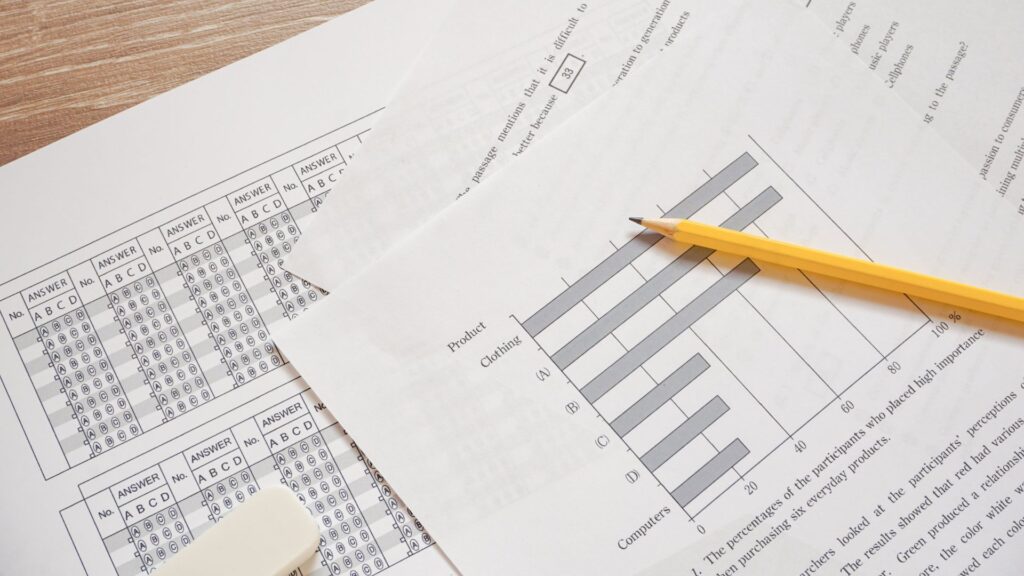It’s official! As of spring 2024, the College Board no longer offers the paper and pencil version of the SAT. It’s entirely digital now. What does that mean for students? Does the digital SAT test the same knowledge? Is it longer or shorter than the paper and pencil version? Do you have to bring your own computer or mobile device to take the digital SAT, and what happens if you don’t have one?
It’s a big shift, but this guide has everything you need to know about the digital SAT.
What Is the Digital SAT?
The digital SAT is simply the online or virtual version of the paper and pencil SAT. You’ll still go to a test center to take the exam, but instead of needing a bunch of number two pencils, you’ll do everything on a computer or tablet.
In many regards, the digital SAT is the same test as always. It’s a tool to assess your college readiness and helps the college admissions committee decide if you’re a good fit for the school.
The digital format also uses the same scoring method as the paper and pencil test. You can score between 200 and 800 on each section for a total score of 400 to 1600. And it still consists of four modules, two reading and two math.
How Is the Digital SAT Different from the Pencil and Paper SAT?
That said, the new digital SAT is a bit different from the paper and pencil SAT — beyond the fact that it no longer requires a pencil!
The digital test is shorter than the paper version. Instead of taking three hours, you’ll have two hours and 14 minutes to complete the exam: 64 minutes for the reading and writing section (32 minutes for each module) and 70 minutes for the math section (35 minutes for each module). The digital SAT also has fewer questions — 98 compared to 151.
How did the College Board manage to “shrink” the test?
It combined the reading and writing sections into a single unit and uses shorter reading passages. Now, they’re about one paragraph long and may include things like poetry.
The test also assesses abilities in areas not previously covered on the test. For example, there may be questions that ask you to read fictionalized notes and analyze the data.
It’s also important to note that the math section of the digital SAT is generally considered more difficult, but now you can use a calculator on the whole test. The paper-and-pencil version had a calculator module and a no-calculator module. While you can use your calculator, the SAT has a built-in tool that you should also learn to use before test day.

Does Everyone Get the Same Questions on the Digital SAT?
Yes and no.
Every student is tested on the same concepts. However, the way the question is worded and when you encounter a specific question may vary even when everyone is in the same room of the same test center on the same day.
Will Questions Get Harder on the Digital SAT?
The reason the questions are similar but different is because the digital SAT is adaptive, meaning it adjusts to the test-taker’s abilities. Here’s how that works.
The reading and writing section and the math section each have two modules, module one and module two. So, if you perform really well on the first math module, the questions in the second math module will be more challenging.
As a result, the SAT you take is unique to you and scaled to measure your abilities.
Is Every Question on the Digital SAT Worth the Same?
Not exactly. Some questions are worth more than others. The explanation is a bit opaque, but here’s what we know.
To make the test shorter, the College Board cut some questions from the test. However, to ensure colleges still had accurate information about an applicant’s college readiness, the College Board had to find another way to measure a student’s ability. That, in part, is how the SAT became adaptive.
Students get a mix of easy, medium, and hard questions in the first module, and their performance on module one dictates the difficulty level of the questions in the second module. Module two questions have a difficulty level that’s generally higher or lower than the difficulty level in the first module.
Because the second module adapts to a student’s performance in module one, scoring includes the difficulty level of the question. Per College Board, “If you get more ‘easy’ questions wrong, you may get a lower score than if you only got ‘hard’ questions wrong.”
Unfortunately, there’s no information about how much a hard question is worth compared to an easy one, but it helps explain why your score on practice tests may not have made sense. Getting more correct answers on a test doesn’t necessarily translate into a higher score.
Do I Lose Points for Wrong Answers on the Digital SAT?
No. Even though correct answers are worth more for harder questions, getting a wrong answer does not decrease your score. Even if you’re wrong, guessing is better than leaving the answer blank. Guessing gives you a shot at getting the points, while leaving it blank guarantees you won’t.
Can You Skip or Go Back to Questions on the Digital SAT?
Just like with the paper version, you can skip and go back to questions on the digital version of the SAT as long as there’s time on the clock. Unlike the paper version, the new digital test has a flagging tool that allows you to mark questions you want to skip and answer later or return to for review.
The test also has a built-in timer to let you know how much time is left in each module and alerts you when time is running out.

Can I Use a Calculator on the Digital SAT?
In short, yes! Calculators are allowed on all math sections of the new digital version of the SAT. While you can bring your own calculator, the digital test has a built-in calculator, Desmos, you can use (something we recommend).
The math section also includes a reference sheet with common formulas you may need in the math modules.
Do I Need My Own Computer or Tablet to Take the Digital SAT?
If you don’t own a computer or tablet, the College Board will loan you one for the test. You can’t use a mobile phone because it won’t run Bluebook, the test-taking tool.
When you register, you’ll indicate if you’re using a personal device, a school-issued device, or need to borrow one. If you need to borrow one, you’ll have to register at least 30 days before your desired test date to ensure the device is at the testing center on test day.
A teacher, school counselor, or administrator may need to verify your eligibility to borrow a device, and you’ll need to arrive at least 30 minutes early on test day to get the device.
Get Prepped and Ready
Some colleges are test-optional while others are bringing it back, and whether you want to take the SAT multiple times or just once, Emergent Education’s tutors can help you be ready for the SAT, ACT, and more.
We’ll teach you the test-taking strategies you need to ace the test, stay on time, and navigate the new standardized testing landscape. Contact us today for a free consultation, and we’ll match you with an online or in-person tutor in the Portland and Seattle area.





